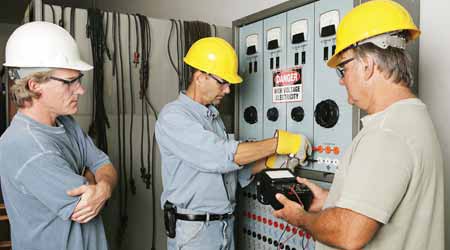 Even as technicians make electrical equipment safe to wrk on, it is still considered am arc-flash hazard, and hey must wear approproate safety gear.
Even as technicians make electrical equipment safe to wrk on, it is still considered am arc-flash hazard, and hey must wear approproate safety gear.Arc-Flash Safety: Understanding The Hazards
Part one of a two part series on arc-flashes
Front-line maintenance technicians and engineers face a host of potential hazards in performing their daily tasks. Among the most dangerous of these hazards, which can occur when working with electrical distribution systems and components, are arc-flashes.
Managers who understand arc-flash events and the standards designed to protect workers from them, will be better able to develop and implement safety programs that protect workers.
Understanding hazards
An arc-flash is a phenomenon in which a flashover of electric current leaves its intended path and travels through the air from one conductor to another or to ground. Serious injury or even death can occur.
An arc-flash can result from many things, including dust, dropped tools, accidental contact, condensation, material failure, and the installation of faulty equipment. Three factors determine the severity of an arc-flash injury: the proximity of the worker to the hazard, the temperature, and the time for the circuit to break.
Temperatures of electric arcs can reach 35,000 degrees at the arc terminals. Lethal burns can occur at a distance of several feet from the arc, while severe burn injuries are common at distances of 10 feet. Clothing can ignite at temperatures of 752-1,472 degrees, and arcs can expel droplets of molten terminal metal of 1,832 degrees or more, burning skin or instantly igniting clothing.
Regulatory matters
Standards from the U.S. Occupational Health and Safety Administration (OSHA) cover many electrical hazards in many different types of facilities. OSHA’s electrical safety standard 1910.333(a) states, “Safety-related work practices shall be employed to prevent electric shock or other injuries resulting from either direct or indirect electrical contacts, when work is performed near or on equipment or circuits which are or may be energized. The specific safety-related work practices shall be consistent with the nature and extent of the associated electrical hazards.”
OSHA’s electrical standards are based on the National Fire Protection Association (NFPA) standard 70E, Electrical Safety Requirements for Employee Workplaces.
Although OSHA has not adopted and does not enforce NFPA 70E, the administration can use the NFPA standard as evidence of a recognized electrical hazard in the workplace, which can lead to a citation. NFPA 70E includes safe-work practices to protect personnel by reducing exposure to major electrical hazards. Developed at OSHA’s request. The NFPA 70E standard provides additional best practices for electrical safety.
NFPA 70E 2015 has some basic requirements for addressing electrical safety facilities. They include:
• safety programs and procedures
• arc-flash risk assessments and reviews every five years
• only qualified persons working within the limited approach boundary of energized parts
• documentable and demonstrable proficiency in electrical safe-work practices for qualified persons
• retraining every three years
• audits of employee performance
• annual training on cardiopulmonary resuscitation and automated external defibrillators
NFPA 70E 2015 also finds that managers can achieve safe work conditions through engineering controls, hazardous energy control procedures and lockout/tagout. This is the most effective way to reduce arc-flash risks, but it is not always possible for front-line technicians to work on de-energized equipment under several circumstances:
• De-energizing offers more hazards and increased risk to workers.
• De-energizing is not possible due to design or operational limitations of the equipment.
• The equipment operates at less than 50 volts where it is determined that there is no increased risk due to arc burns or explosions
• There are normal operations where proper engineering controls are in place and there is no evidence of impending failure.
If a manager finds that a situation involves one or more of the first three criteria, the mandated step is to implement proper personal protective measures in conjunction with the components of the facility’s electrical safety program.
It is also important that managers recognize even during the process of making electrical equipment safe to work on — creating a zero-energy state by using lockout/tagout measures — it is considered energized until the authorized employee has proven otherwise. Without this verification, technicians must wear shock- and arc-flash personal protective equipment (PPE) until verification is made.
Related Topics:













